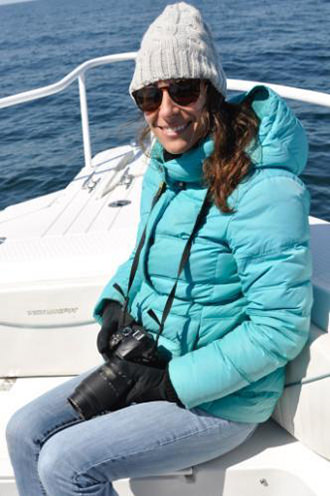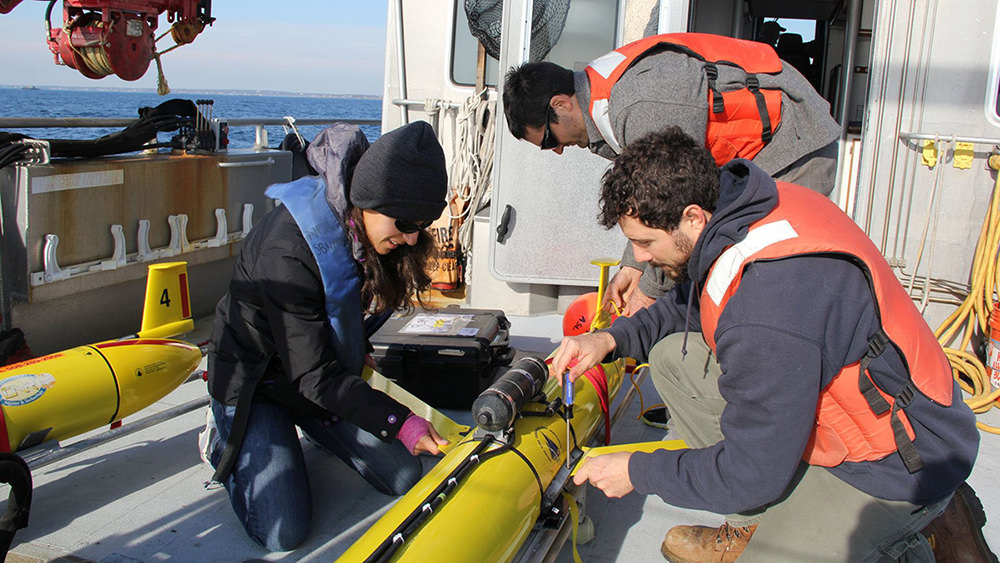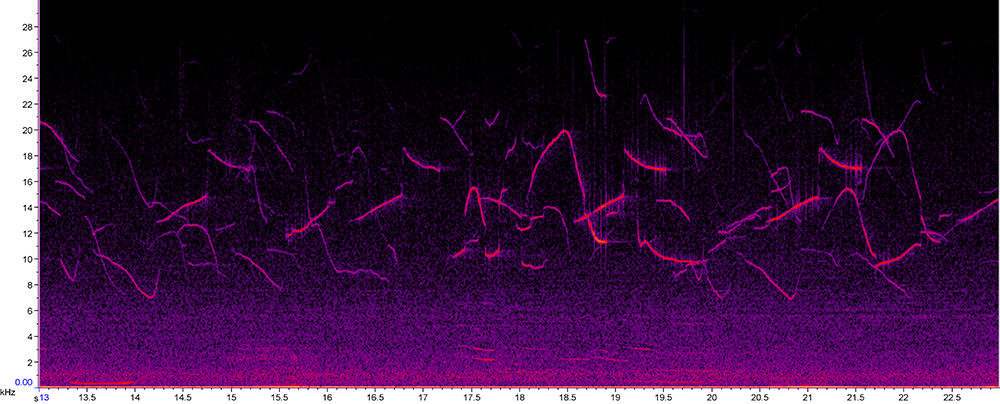From watching whales to searching for dolphins: Foster Scholar Tammy Silva's scientific career revolves around Stellwagen Bank
By Yaamini Venkataraman
December 2017
It was the first time anyone had tried listening for dolphins in Massachusetts Bay. Tammy Silva scrolled through sound recordings and spectrograms for months, seeing nothing. Then, she found it. The right kind of squiggly lines and corresponding whistles. She heard dolphins.

Stellwagen Bank National Marine Sanctuary is a known whale paradise. With plenty of food for whales to chow down on and its proximity to Boston and Cape Cod, the sanctuary boasts some of the best whale watching in the nation. Silva herself is an avid whale watcher — growing up near Stellwagen Bank, she would go whale watching in the sanctuary with her family. Those trips are what forged a connection between Silva and Massachusetts Bay.
As a Ph.D. candidate at the University of Massachusetts, Dartmouth, and a Dr. Nancy Foster Scholar, Silva jumped on an opportunity to work in the sanctuary for her dissertation. While humpback whales are the best-known visitor to the sanctuary, dolphins are also prevalent. However, less is known about these animals and how they use Stellwagen Bank. Silva traded her pastime of whale watching for a quest to find dolphins for research purposes. The species Silva studies, Atlantic white-sided dolphins and common dolphins, play a vital role in Stellwagen Bank National Marine Sanctuary, Massachusetts Bay, and the larger Gulf of Maine region. By being the first to focus on dolphins in the sanctuary, Silva can better articulate the importance of these mammals.
The sanctuary already serves as a crucial feeding ground for a variety of species, like baleen whales and cod. Silva believes dolphins could use the sanctuary in the same way. Specifically, she wants to know when they are in the sanctuary, their exact positions, and if those patterns differ between her two species. Dolphins are apex predators – they help structure ecosystems by feeding on certain prey and influencing prey movement – so their presence can strongly impact ecosystem dynamics.
“You have this important ecosystem,” Silva says. “It’s an area with lots of human activity, including fishing, commercial shipping, and vessel activity. It’s really the perfect living laboratory.” By studying dolphins in the sanctuary, she can begin to understand how they influence the ecosystem, and also how they are impacted by human activities.

Before she can understand how dolphins use the sanctuary, Silva has to find them. Luckily for her, whale watching boats have been out in Stellwagen Bank National Marine Sanctuary for decades, recording each animal sighting. Silva uses a long-term database dating back to the 1970s to see if there are certain years or areas where dolphins are more prevalent.
While whale watching boats provide important information for Silva, there are still plenty of missing pieces. For example, whale watching boats only go out from late spring to early autumn. To find dolphins in the winter, Silva uses passive acoustic monitoring to complement her visual sighting data. Working with Mark Baumgartner and advisers Aran Mooney and Laela Sayigh of Woods Hole Oceanographic Institution, she attaches hydrophones to autonomous underwater vehicles called gliders. The gliders are released into the sanctuary, where they continuously record all of the sounds around them. If dolphins are around the gliders, she can hear them.

“If you look at when [whale watching boats] go out from April to October, we tend to see dolphins on 15 to 20 percent of the trips. It’s not that often,” Silva says. “But we did our passive acoustic surveys in the wintertime and detected animals on approximately 75 percent of the days we were monitoring. In some months like December or January, we detect animals every day or almost every day. They’re out there in the winter more often than anyone thought.”
According to Silva, comparing acoustics with whale watch data is “like comparing apples to oranges.” Whale watching boats are limited by weather and sea conditions and must depart at certain times of day, while gliders can collect data 24/7 throughout the year. One thing Silva hopes to do in the future is deploy a glider in the summer to get higher resolution information about the whereabouts of dolphins during that season.

Silva finished her Ph.D. and defended her dissertation this December, but that’s not the end of her relationship with Stellwagen Bank National Marine Sanctuary. In January, Silva will begin a post-doc position with the sanctuary.
“One reason I’m so passionate about Stellwagen is that I grew up here, and it’s in my backyard,” Silva says. “Before I started graduate school I already had a passion for ocean conservation. The inspiring relationships with staff and scholars, and the experiences I had as a result of the [Dr. Nancy Foster Scholarship Program], have strengthened that passion and created a lifelong commitment to spreading the word and protecting our ocean’s special places.”
Reflecting on her graduate student experience, Silva is nothing but grateful for her time as a Dr. Nancy Foster Scholar. “Foster Scholars are a relatively small but growing community, a tight-knit group of incredibly talented, inspiring, passionate, kind, and fun people. I’m honored to be among them and count them as colleagues and friends,” Silva says.
Embracing all she’s learned and channeling those who have inspired her, the newly-minted Dr. Silva will be where she’s always been, doing what she’s always done. You can find her in Stellwagen Bank National Marine Sanctuary, working to protect the backyard she loves so much.
Yaamini Venkataraman is a volunteer social media intern at the NOAA Office of National Marine Sanctuaries and a graduate student at the University of Washington.

